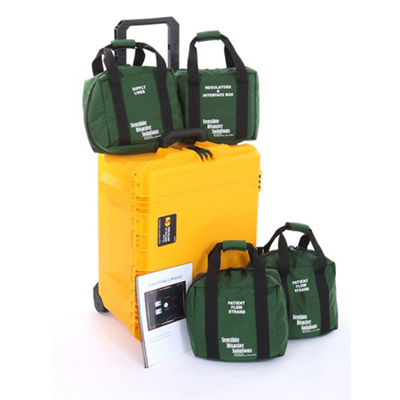An oxygen delivery system helps provide a supplemental source of oxygen to patients. Mass oxygen distribution systems are often used by health care professionals in mass casualty events. Because proper oxygen could mean life or death for patients in emergencies, having the ability to provide medical oxygen to several patients at once saves lives.
What Is a Mass Oxygen Delivery System?
A mass oxygen delivery system is a large oxygen delivery system that provides a high flow of oxygen to patients in a hospital or pre-hospital setting. It’s different from your typical home oxygen distribution system; A mass oxygen delivery system provides high-pressure oxygen flow to many patients at the same time.
When to Use a Mass Oxygen Delivery System
A mass oxygen delivery system delivers high purity oxygen in large quantities and at a specific flow rate (adjusted with a flow controller). They are often used in mass casualty events where multiple patients require supplemental oxygen. However, they’re utilized any time oxygen needs to be supplied to more patients than available individual oxygen tanks and delivery systems.
Mass Casualty Events
An event is classified as a mass casualty when the amount of injured patients exceeds the local resources for transport and care. In a mass casualty event, the first priority is to tend to the injured. First responders should locate victims and perform triage to determine the severity of injuries. This event is defined differently than a mass fatality event, where the number of fatalities is greater than local resources can address. However, a mass casualty event can also classify as a mass fatality.
Mass casualty events can result from both natural and unnatural causes, any of which could cause airway blockage or lack of oxygen in victims.
How Are Mass Oxygen Delivery Systems Used?
To understand how a mass oxygen delivery system works, first consider how the oxygen is delivered and stored. Oxygen can be delivered in either liquid or gas form. Liquid oxygen is typically used for emergencies because it can be stored in large oxygen cylinders. Gaseous oxygen has higher pressure than liquid and requires less space, but it must be stored in high-pressure tanks that need to be maintained by trained technicians.
Oxygen Concentrators
Not all oxygen delivery systems solely rely upon medical gas in an oxygen tank. Oxygen concentrators (also known as oxygen generators) draw in room air, which is then filtered to remove dust, bacteria, and other particles. The concentration process results in the patient receiving concentrated oxygen of about 90% or higher. Portable oxygen concentrators are smaller and lightweight. They are compact and easily fit into emergency vehicles.
How to Choose the Right Oxygen Equipment for EMS Use
EMS supplies are rarely used in hospital settings; because of this they have special requirements when purchasing. They have to be reliable, portable, and durable. Plus, they often need to work on multiple patients to address more injuries as quickly as possible.
When it comes to supplying oxygen equipment, there are important factors to consider before stocking your ambulances or emergency vehicles. First, you should consider the oxygen supply needed and ensure the vehicle can accommodate this storage. Secondly, how portable is the equipment? Providing care in emergency situations is often done in the field without power sources. The best equipment can run on its own power and be lightweight enough to carry it to where it’s needed. Third, can this equipment be used on multiple patients? In mass casualty events, there may be a need to provide care to dozens of people. Can the equipment service multiple patients at once without causing a potential biohazard?
TOAD: Total Oxygen Administration Device
The Total Oxygen Administration Device (TOAD) is a type of mass oxygen delivery system used for oxygen therapy. TOAD is most commonly used with patients who require continuous delivery of high-flow oxygen via conventional nasal cannula or tracheal tube.
This unique system utilizes both high pressures as well as liquid oxygen VGL sources. The system is scalable, extremely portable and cost-effective. The TOAD does not require a power source and can provide oxygenation for up to 27 hours with a large oxygen cylinder. Additionally, the TOAD can accommodate up to 24 patients at once, making it a perfect choice for distributing oxygen in mass quantities. The TOAD is guaranteed to last with a five-year warranty from the manufacturer.
TOAD Contents:
-
- 1 Liquid Oxygen Regulator
- 1 Cap, Liquid Oxygen Regulator
- 2 in Gage CGA 540 Pressure Reduced (for H Cylinder)
- 1 TOAD, Hammond Enclosure (Interface Box)
- 2 Supply Hose Assembly (for Hammond Box) 20 Foot
- 2 Patient Oxygen Supply Strand
- 1 Pelican Case
- 1 Flow Regulator Carrying Case
- 1 Supply Hose Carrying Case
- 2 Patient Strand Carrying Cases
- 1 Operator Manual
VORTRAN E-Surge Kit
The VORTRAN E-Surge Kit is an emergency backup for a ventilator surge. It uses a single gas source for multiple GO2VENT Automatic Resuscitator products. Other benefits of the kits include four oxygen flowmeters, seven port multi-outlet manifold with pressure regulator and gauge, and a heavy-duty oxygen hose, all in a watertight case.
The VORTRAN Kit comes with six GO2VENT devices. This device provides hands-free ventilator support using a secure airway. Because it runs without electricity or batteries, it is ideal for mass casualty events and other emergencies like natural disasters, disease outbreaks, and major power outages.
FloTec Oxygen Distribution Manifold
The FloTex Oxygen Manifold System is another useful tool in mass casualty events or anytime multiple patients need oxygen support. It can distribute oxygen or other medical gas, can support six patients simultaneously, is versatile for a range of environments, and has quick deployment for fast care.
Find Your Oxygen Delivery System Supplies at Penn Care
Penn Care is your trusted source for all emergency medical supplies. Find an array of oxygen distribution systems that can benefit both individual and multiple patients. Buy full systems like the TOAD, VORTRAN and FloTec kits or individual items, including face masks, catheters, pulse oximeters, nebulizers, CPAP machines for emergency use and more — for both adults and pediatric patients.



